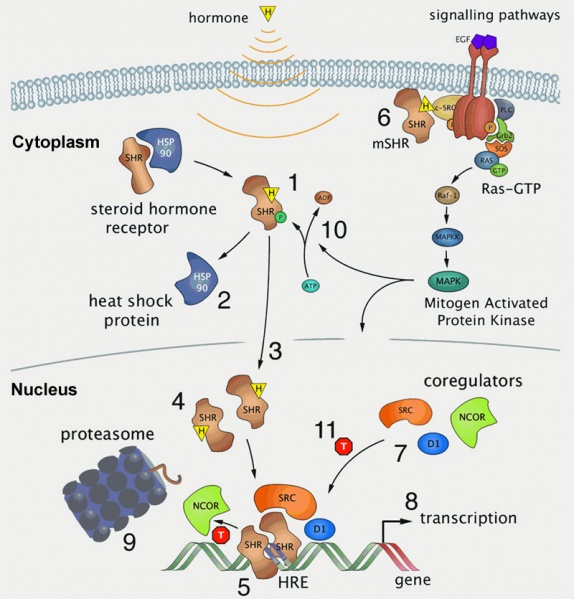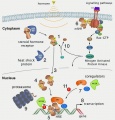File:Steroid hormone receptor signaling.jpg

Original file (800 × 835 pixels, file size: 105 KB, MIME type: image/jpeg)
Steroid hormone receptor signaling
| Steroid Hormone Receptors (SHR) act as hormone dependent nuclear transcription factors.
Upon entering the cell by passive diffusion, the hormone (H) binds the receptor, which is subsequently released from heat shock proteins, and translocates to the nucleus. There, the receptor dimerizes, binds specific sequences in the DNA, called Hormone Responsive Elements or HREs, and recruits a number of coregulators that facilitate gene transcription. This latter step can be modulated by receptor antagonists like tamoxifen (T), and cellular signalling pathways. |
Legend
|
- Links: Endocrine System Development
Reference
<pubmed>17464358</pubmed>| PMC1853070 | Nucl Recept Signal.
Copyright
© 2007, Griekspoor et al. This is an open-access article distributed under the terms of the Creative Commons Non-Commercial Attribution License, which permits unrestricted non-commercial use distribution and reproduction in any medium, provided the original work is properly cited.
Original file name: Figure 2 Big_nrs05003.f2.gif http://www.nursa.org/ejournal/published/05003/big_nrs05003.f2.gif
File history
Click on a date/time to view the file as it appeared at that time.
| Date/Time | Thumbnail | Dimensions | User | Comment | |
|---|---|---|---|---|---|
| current | 18:11, 5 October 2010 |  | 800 × 835 (105 KB) | S8600021 (talk | contribs) | ==Steroid hormone receptor signaling== Steroid Hormone Receptors (SHR) act as hormone dependent nuclear transcription factors. Upon entering the cell by passive diffusion, the hormone (H) binds the receptor, which is subsequently released from heat shock |
You cannot overwrite this file.
File usage
The following 4 pages use this file: